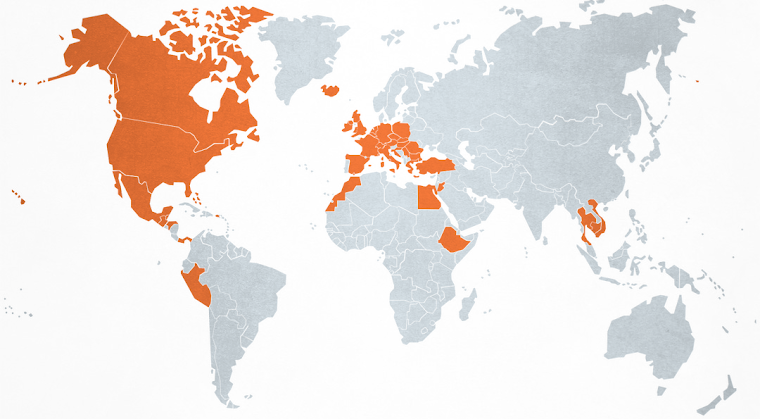After being jostled to death for several hours by the bumpy rut-filled roads, we reached the river where we awaited our next form of transportation. Our wooden boat soon arrived, piloted by a man clad in nothing but a beaded loincloth. He was from one of the local native Embera tribes, and was ready to guide us up the river to his small village. We clambered into the canoe and drifted away from the shore, embarking on our river portion of the journey. Fortunately, some modern technology had spread to this region, and our boat was equipped with an outboard motor, sparing us from having to endlessly row upstream all day and expend our muscles in the process. Along the muddy river we passed by small groupings of wooden huts, each belonging to another village of native Embera tribespeople. Occasionally, children would run to the riverside and furiously wave to the strange passersby, excited for the brief interruption of their daily lives by these curious visitors. Cruising along the calm river was a welcome respite from the earlier bumpy car ride, and I enjoyed admiring the jungled scenery around every riverbend and watching the colorful birds flying overhead.
Several miles into the expedition, we landed at our destination, astride a swath of muddy beach. We followed our guide headlong into the jungle path, ducking past overgrown trees and climbing over vines and brambles. There was a break in the path as it led to a smaller river, which we carefully crossed by gingerly tip-toeing over wooden planks laid across the span, each board sagging into the river with every footstep. Upon successful crossing of the river without any casualties, we progressed along the path until we reached a spectacular waterfall hidden amidst the jungle brush. This was such a serene spot that we all stopped and stared, entranced by the view. After ample time, the guide notified us that we must continue onward, and abruptly broken from our spells we trudged forward through the underbrush.
A short while later we approached a clearing in the woods and were soon greeted by smiling tribespeople who welcomed us to their humble village. They ushered us past sturdily-built wooden buildings on stilts, built to protect the inhabitants from flooding and from unwelcome wildlife. There were many houses scattered about, and within the center of the village was a school and an adjacent large building for community gatherings. We climbed up into this broad central room and sat down to a table laid with plates signaling the advent of our lunch. The scents of freshly fried fish and plantains wafted through the air, and set my mouth watering. The meal was quickly devoured, not out of respect to the hosts, but as a true testament to the deliciousness of the proffered food that was freshly and locally sourced. The plentiful food was the perfect antidote to a growling stomach that was ravenous from a long and draining trek through the jungle. Contentedly sitting back with a full belly, I listened as the tribe leaders explained the story of the indigenous Embera people and how they continued to eke out an existence in the tropical regions of Panama. They explained their customs and daily routines, and then called out for the rest of the tribe members to display their native music and dancing while dressed in their colorful and traditionally handmade clothing. They sang and exuberantly danced in a circle, expressing the joy that can only be found from living contentedly despite their meager means.
After this immersion into the Embera lifestyle, we were invited to follow the tribe’s medicine man into his jungle domain and look at the different plants that are used to heal various ailments. Through an interpreter, he described each of the native plants within his garden, and how specific parts of each plant can be either curative or deadly, demonstrating the skill needed to differentiate each plant. Stomach pains, headaches, infections, diarrhea, and impotence were all some of the minor conditions which were touted to be cured by any number of these native plants, and this information was fascinating for the pharmacist-centered curiosity which always dwells within my core. While I don’t intend to add these latest treatments to my armament of medications, there is extensive science behind the curative properties of certain plants, leading to the creation of drugs used today – aspirin, belladonna, opioids, cannabis, etc.
Armed with this new knowledge and rejuvenated from an afternoon spent with the local tribespeople, I said my reluctant farewells as our time together came to a close. I had learned some valuable lessons from these pleasant people, proving that you don’t need material wealth to be content. Always wear a smile and treat everyone you meet like a welcome guest, and your outlook on the world can remarkably shift. This is a much-needed mantra in today’s divisive environment, and exemplifies that only through kindness and unity can we hope to achieve a better society for all. If only we could all strive to be more accommodating like the Embera tribespeople, we could leave the world a better place for those who follow in our footsteps.
Typical dugout canoes used by the Embera people today
Passing by another Embera village along the route
Traditional wooden houses on stilts
Exhibiting their native music and dancing
The village chief is playing the flute
Following the medicine man into the woods
The medicine man is explaining the curative properties of his plants








No comments:
Post a Comment